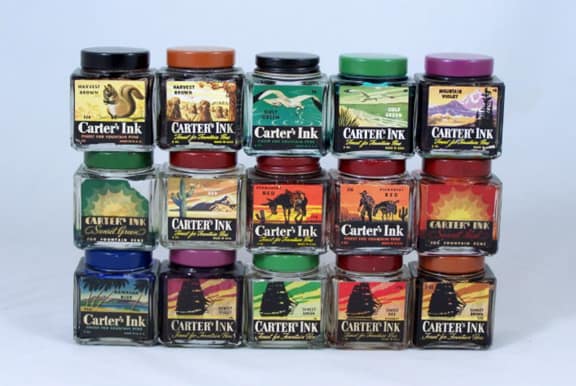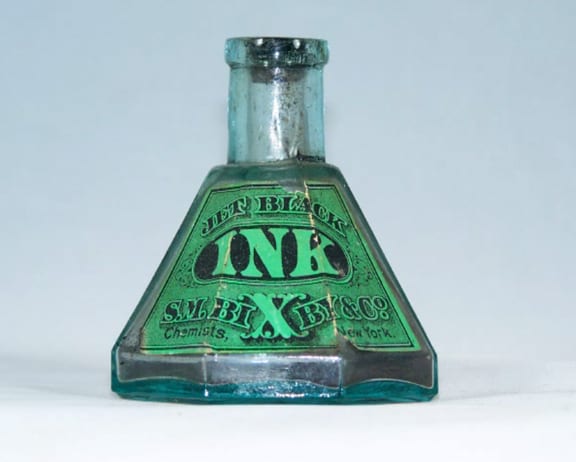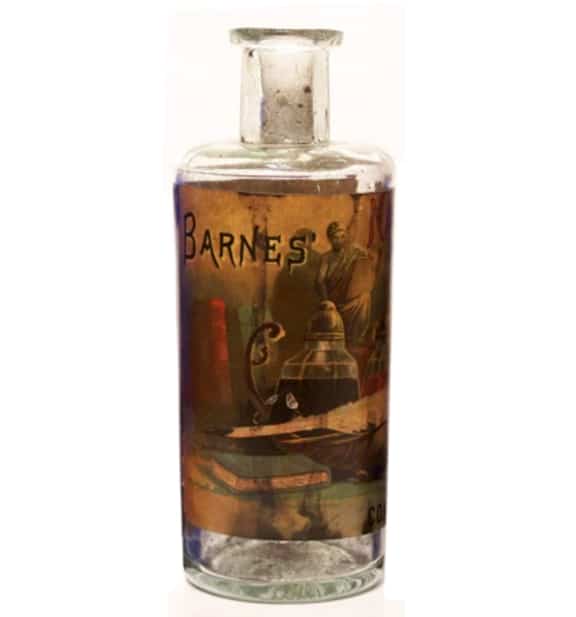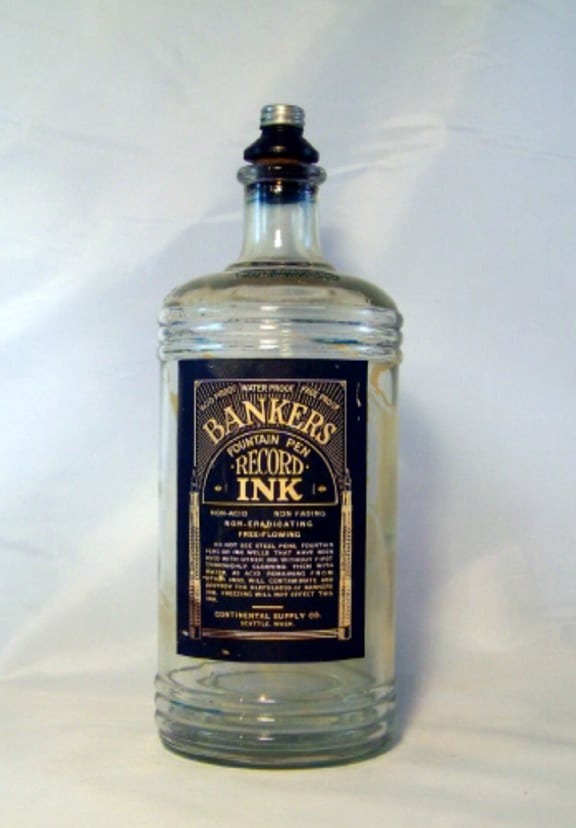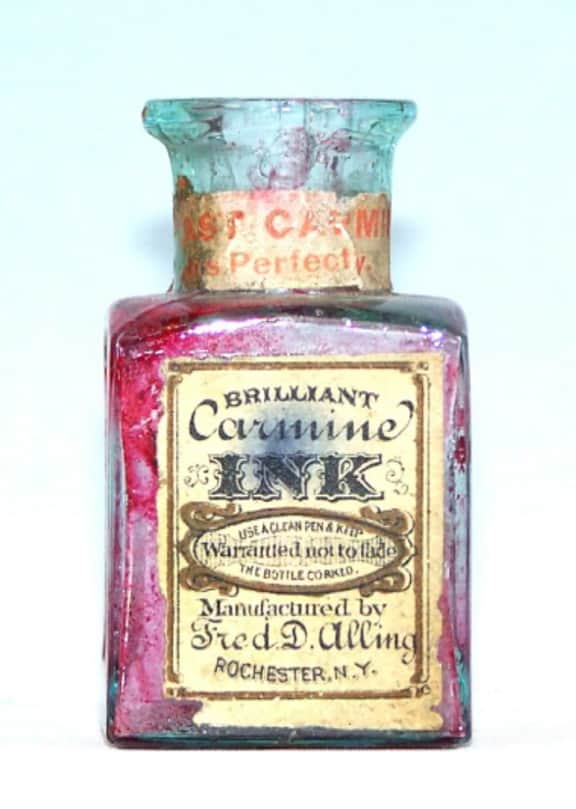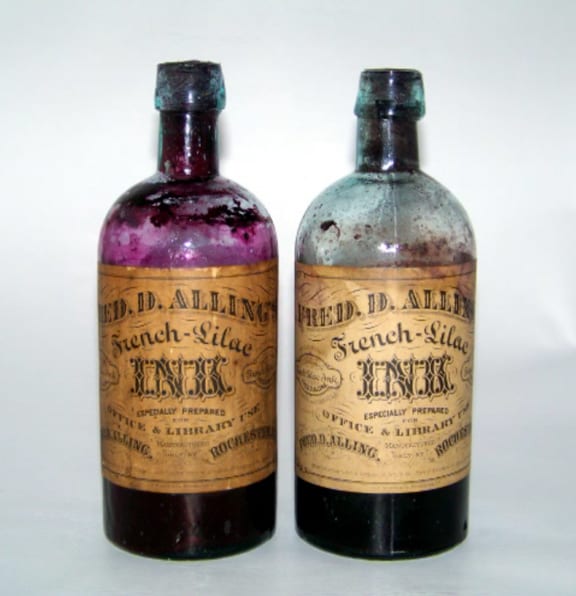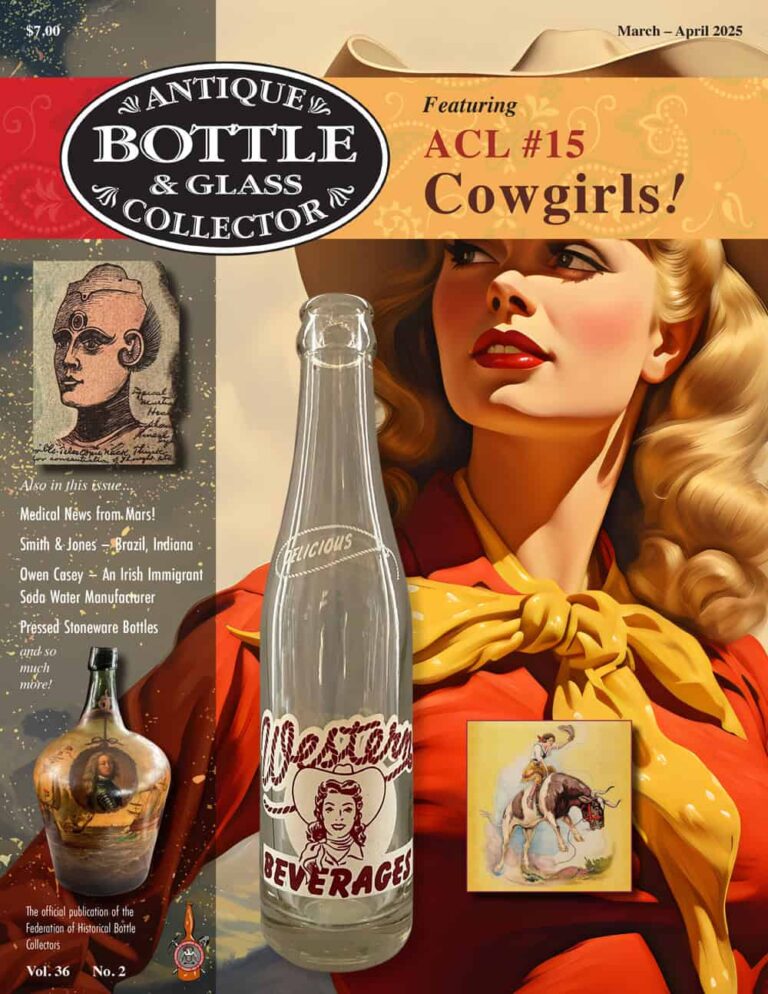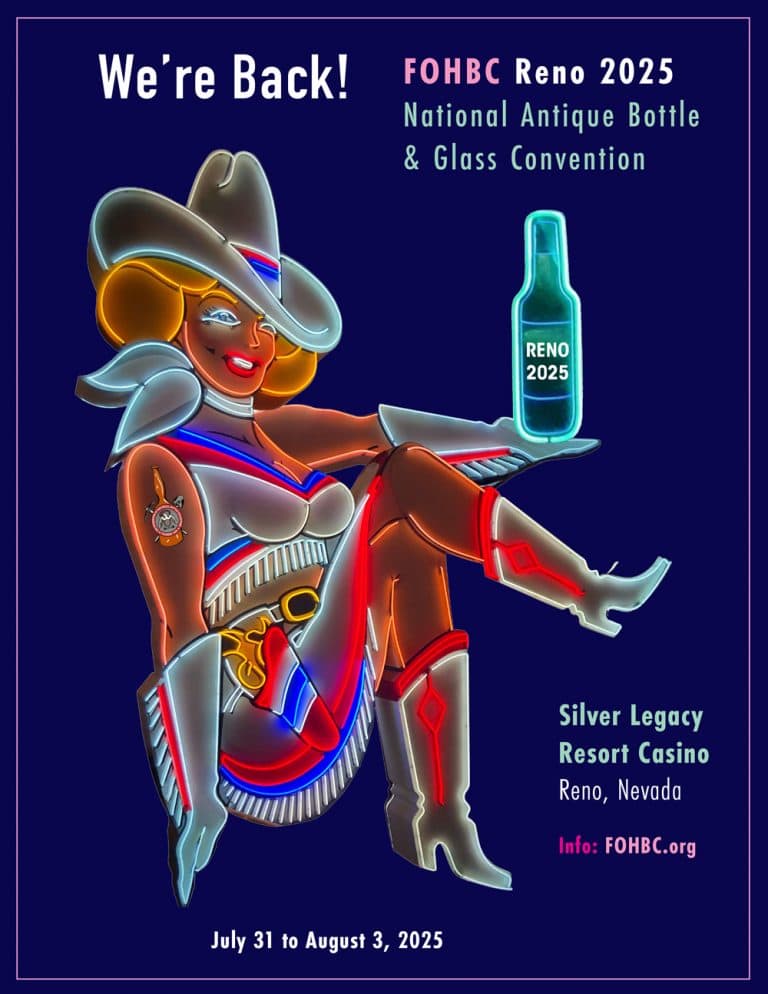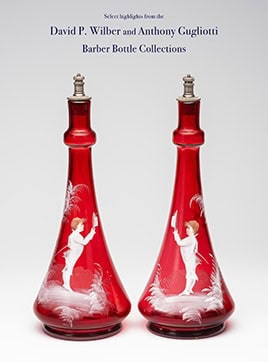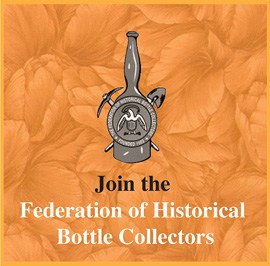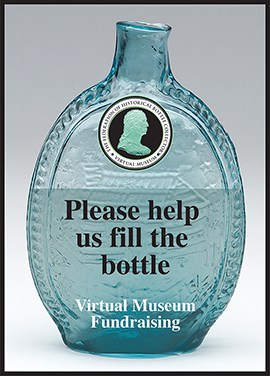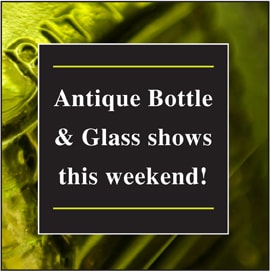WHY I COLLECT PAPER LABELS
by John hINKel (copyright 1995 rev1)
Well . . . to tell the whole story. After collecting clocks for more than thirty years and while having acquiring quite a number, the collecting was not going well. What I had collected would never be worth much. The desirable clocks were too outrageous in price, and I had bought too many at the junk end of the line. I was buying more what I liked, was interesting, different, cute or what I thought I could afford rather than trying to develop a specific collection. In addition adequate research was not done either before or after. I was a case of “I got another one” and that was about it.
Anyway, I decided to change my direction of collecting. In 1990 we were traveling and had stopped at an antique shop in Doolittle, MO when I decided to start collecting inks. Bottles are not only easier to display and store, but they are also less expensive than clocks. I bought three masters inks for $9.00; after all ink is in my name (hINKel). Not only that but fountain pens and bottled writing inks, especially the “masters” are fading into history with the arrival of a successful ball point pen. My father had operated a printing and office supply business, had collected bottles, inks and Coke Cola. At his death in 1968, he left me the remains of both these groups. These collections were relegated to the basement, since my thing at that time was clocks. When we got home after buying the three masters, I “dug” out the ink bottles my father had left me, twenty-five in all. Low-and-behold, they were all labeled, and the ones I had just purchased weren’t. The labeled ones looked so much nicer. At that point, I decided to limit my collection to the paper labeled inks. As I developed the collection, I have discovered that there is an abundance of ink bottles. Some of these bottles are not too desirable, some super expensive, and quite a few that the ink community considers very collectable, most without a label. The limiting my collecting to paper labels, has proved to be a great benefit by narrowing the field even more. I get to look a lot without having to purchase to much. Sometimes, this is more than a little frustrating though. I think that all but the very earliest bottles had labels. Most bottles have at least one area that is smooth enough to accept label. I even have examples where the label is applied over the embossing. The majority of these labels have disappeared through use, being buried or by being washed off by a collector looking only for glass color. As a little side light, when I bought my first three inks, there was a labeled bottle that I could have selected, but it was mucilage.
Now why the paper label, I’ve already said that they provide a limiting parameter for the collection, as they are less common. Over and above that, the labels tell exactly what was in the bottle, and more often about the manufacturer and their other products, than the embossing in the glass does. As I collect inks there is no question that, when there is a label, this given bottle is an ink, and not mucilage nor a shoe polish, but an ink and more than likely the label will even tell me what color the ink was. In addition may tell me what an outstanding product this is and all the benefits from using it. They tell a lot about the period of manufacture, sometimes exactly, and other information such as manufacture’s offices, quantity, quality, color, cautions, etc. Labels tell whose products were in “stock” and non embossed bottles. If the bottle is of colored glass, most labels do not hide that color. Labels add color and character to both pottery bottles and clear glass containers. The graphics can even be outstanding works of art. Label graphics add eye appeal and decoration while informing the literate, yet also give an additional visual reminder to those who cannot read. Otherwise it is only the bottle color, shape and a limited amount of embossing that must perform that function. And shape is not always a good indicator; I’ve seen ink in what would be called whiskey and water bottles, if it had not been for the label. The label does make it a little more difficult to display bottles with a back light, but very pleasing displays can be achieved without the added cost of backlighting. Labels reduce the risk of getting fakes, because the label is something else that has to be reproduced. [I do know there are some cases of applying New Old Stock (NOS) labels to old bottles. I’ve not settled with myself if this is OK, even if applying the proper label to the correct bottle. Research is required, usually old catalogs, to determine correctness whether you are applying or buying. Is there a difference in putting a hundred year old label on a hundred year old bottle today, rather than having it applied a century ago? I don’t know. It is a definite no-no to apply an old label to an incorrect piece of glass and I know this does happen.] There are still bottles with labels made before the turn of the century and the arrival of the automatic machine. Not as many, but they are still out there. Now it has been nearly one hundred years since those machines were first-put into production, so how old is old.
Manufacture’s recognized that the label provides more color than the glass and were cheaper. In addition they are easier to change and update. This is probably the main reason for the evolution from colored glass to colored labels, along with improved glass formulas and in the general literacy of the public. Look at today’s products, clear glass with lots of label. The quality of the label followed the developments of the printing trade. Labels enhance the value of a bottle. Labels used to be soaked off, reducing the supply of labeled bottles. This lack of labels makes the search more challenging and reduces the number of items to acquire there are millions of inks out there. Of course the better the condition of, the label and the bottle, the more valuable it can be. The prices of any item, needs to have age, quantity (availability) and the “fad factor” figured into it. Local ink maker’s bottles are scarcer, but the demand is usually local. Labels help insure that the bottle will be in good shape; if the label has survived, the bottle will have been treated well. Labels make it more of a collection of history, rather than a just a collection of colored bottles.
Of course there are some disadvantages to labels as well. They are fragile and can be easily damaged. As with most things, quality does vary. Those on better paper and printed with better inks will, of course, last longer. Some labels were done on cheap paper and are more susceptible to damage than others. These labels are rarely perfect as they can be easily torn, stained and wrinkled, and continual handling can rub the printing off. The ultraviolet rays of the sun will fade them, so don’t save your unlabeled bottles in the window. Fluorescent lights will also cause fading, only slower.
OK I’ve started a bottle collection, now what? Where do I find out more about what I collect and have collected? Where do I get more and better bottles? You join a club to find common interests and directions, research the libraries and books and talk to the experts to learn more. Still how do I add to my collection? Here are some suggestions.
Shows – subscribe to Bottles and Extras or Antique Bottle and Glass Collector to find show schedules. You may have to travel to some shows. Your club members can probably give you information about which shows are the better ones.
Dealers – They usually have ads in the bottle magazines or you can meet them in person at a show.
Auctions – Bottles and Extras often publish a list of auction houses that deal in bottles and their upcoming auctions.
Shops – Antique, bottle, flea markets, junk shops, etc. Labels seem to stand out among all the other items on the shelf, not necessarily inks but all labels.
Friends – Other bottle collectors, other kinds of collectors who are out and about and neighbors (who just happen to – have, see or know of.)
Advertise – Wanted sections of the classified ads in bottle magazines (best), collector publications (Antique Week, Antique Trader, etc.) and newspapers.
Digs – (dumps and privies) get an experienced partner for safety. Labels on dug bottles are very rare but can be found. The label happens to get covered by something, such as a bundle of newspapers, which protects it. These are usually in poor condition.
Through all this I did learn a great deal about collecting. Buying “what you like” is OK, but probably won’t bring you any return on your money. Then if you buy only to speculate you will more than likely lose money unless you are extremely well educated and very lucky. Buy what you like but be selective about it. When starting a new collection, you need to make a conscientious decision as what to collect. Why you are collecting? Do you collect just because you like it, as an investment, to improve my knowledge, or to contribute to the collecting world? Do make it something that you have an interest in or want to find out about. Setting goals, limits you to collecting a selected field and sticking to it. Before you begin buying, do some research on the subject so that you can embark on your quest with some knowledge? If nothing else, this will help you from paying too much or getting taken by some not-so-ethical dealer. Sure there will be times when you will pay too much for an item, but then there are many other times where you will find bargains. Often I’ve passed on a good item that I thought was just a little high. Then later find a like item for a much lesser price and in better condition. I’ve even passed on a bottle and then later bought the very same bottle for half the previous price. There have been only a very few times that I regret that I did not buy a bottle. When buying anything, also consider how this given item will affect the total collection. Most importantly – buy the very best that you can afford. Upgrade when you can, weed-out the culls. The more narrow the field, the more challenging the search, but the greater the rewards. Variations such as collecting a single bottle style with all the label variations that can be found can add variety to the search. “Go-Withs” these are related items, such as advertising, and in the case of inks, pens, inkwells, blotters and the like to enhance a display. Just watch that you don’t end up collecting the go-withs, unless it is a conscientious decision. There is one other thing to consider, the size of what you are collecting. Tractors take up a lot more space than coins.
In doing these things will give you a collection that has merit, quality and will make a contribution to the world of collecting. It will also make yours a collection that you can be proud of.
There are times I wonder why other bottle people consider collectors who collect bottles made after the turn of the century not true bottle collectors? Is it just because bottles started to be machine made then? Should a bottle be any less valuable just because it was machine made? There may be a need for second thoughts on this.
Scarcity is what collecting is all about. Admittedly no one wants what everyone else has; there is no challenge in that. Yet, bottles made today may well become more scarce that those of a hundred years ago. True the older the bottle the longer it has had to survive but it does not follow that they are any scarcer. Yet a machine bottle can be scarce due to a limited production run, a company going out of business, etc.. The converse is also true, the automatic machines allowed the manufacturing of more bottle. Due to this there was less of a tendency to save them for reuse, for there is always another. The trend toward recycling of glass also reduces the supply. The likelihood of a bottle surviving today is still less than it used to be. Today we are even more of a disposal society. For example, the Anchor Hocking Co. made a ruby red beer bottle for the Joseph Schlitz Brewing Co. They made nine varieties between 1949 and 1963; the first 6 were experimental with quantities limited to 100. The production of the last 3 varieties equaled a total of 54 million. Though there is an estimate that for every million of these bottles produced, only 3 or 4 have survived1. Just remember that the bottle you collect today was someone’s trash yesterday. Not only are we a throwaway society there is the additional fact that today plastic is rapidly replacing glass. If you look on the shelves, you’ll see there are fewer products in glass. By the year 2020 the machine bottle will be one hundred years old.
As far as characteristics go, the only thing you won’t find on today’s bottle is a punty scar. Everything else found on an “old bottle,” can be on a bottle manufactured tomorrow. Like the old ones, the modern bottle can have whittles marks, flaws, bubbles, distortions, haze, and stains. Since these “defects” don’t occur nearly as frequently and reach the public still less often. Should not these examples also have value?
Identification of the modern bottle can be as difficult as figuring out the use of the old ones. Bottles that are only a few years old (how quickly our memory fails), can be difficult to identify without the label. Embossing has fallen by the wayside due to the cost. The need for it is no longer required with the improvements in labels and other forms of advertisements which cost less. Patent dates also can be misleading. How do you deal with a bottle with 1868 patent number and a seam over the top of the lip? Was the same design used for fifty years or was it made on an early machine?
Part of the answer may be there is a major break point in bottle manufacturing in the early 1900′s. This is the period the automatic machines came on to the scene. There were several attempts at developing an automatic bottle making machines during decades before Owens’ patented his machine in 1903/4. Not all the efforts were failures, so there were machine bottles before the turn of the century. It is just the Owens’ machine was the most successful. Yet with Owens’ success, still not all bottle makers bought a machine until well into the Twentieth Century. Uniqueness is not a reason for value either. A one-of-a-kind bottle is only valuable if it is famous (I don’t see thousands of dollars offered for our display awards.)
A similar riff also exists among car collectors. Many old time automobile collectors think anything after World War II is junk. But, newer collector cannot afford the tens of thousands dollars for a prewar car. They must settle for the cars of their youth or wait until their second million. In both these circumstances, many older collectors consider the collector of the newer item a second class collector. Yet these younger collectors of today are the base for the continuation of the hobby. Take it as fact, those who do not think of themselves as equals in a group will go their way alone. Either this or they will form a group where they are equals. Really we are not second class collectors! Poorer, maybe, or are we just smarter to collect something a little less expensive but just a challenging. Sure there are more bottles made today than yesterday, but there is also, I hope, a larger collector base, and appreciation does happen. And who knows about plastic, especially plastic that is designed to degrade. (read more about John Hinkel at Peachridge Glass)
